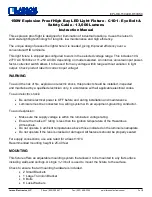
55M4300CCE00 Rev A
remember to make the last derrick motion boom up. Carefully lift the test load just clear
of the ground.
2)
Use
“
”
or
“
”
to modify the load adjustment factor until the
displayed load is equal to the test load. Press
“
”
to accept the change, the
system will confirm the calibration is saved.
3)
Press
“
”
to return to the main calibration menu.
Carefully set the test load on the ground.
Step #20: Attachment “Load offset”
This feature is optional and can be omitted if the displayed load is judged acceptable, it
is normally used in tandem with section 3.10 ‘load adjustment’. A separate load offset
calibration is available for each and every jib attachment and is used to improve the
accuracy of the load on hook indication.
Use the load checks performed in section 3.10 to establish if a “load offset” is required.
“Load offset” should only be used if the load reading indicates a constant fixed load
error for the complete operating range, it allows for a positive or negative fixed value
offset to be applied to the displayed load. If the error is variable then verify all data
entries required in the dimensions area of the chart file are correct before proceeding.
It is recommended that this procedure is done with the machine on outriggers or
crawlers.
A known test load is needed to perform this calibration and should be between 50% and
90% of SWL for the configuration to be calibrated. This SWL should be based on the
capacity with a boom angle of approximately 60°.
The calculated test load should normally include the weight of the hook block and any
slings, shackles etc. that are used.
Ensure the current duty selection matches the actual crane configuration to be
calibrated.
Summary of Contents for i4300
Page 2: ...55M4300CCE00 Rev A ...
















































